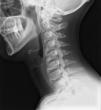We present the case of a 36-year-old woman with diffuse idiopathic skeletal hyperostosis especially at cervical spine since she was 29 years old. The only relevant feature was the use of isotretinoin at regular doses in the past for severe acne.
Se presenta el caso de una paciente de 36 años con hiperostosis anquilosante vertebral difusa de predominio cervical desde los 29 años. El único antecedente a destacar es el uso de isotretinoína a dosis adecuadas para el tratamiento de acné severo.
The use of isotretinoin is common for the treatment of acne. Patients are used to give their informed and written consent before treatment for the risk of teratogenicity. However, many of them are not aware of the possible skeletal side effects at long term.
Skeletal hyperostosis is rare in young patients. As rheumatologists, in patients with diffuse idiopathic skeletal hyperostosis we are used to ask well-known comorbidities such as obesity, high blood pressure, diabetes mellitus, hyperinsulinemia, dyslipidemia, and hiperuricemia.1 However, the use of isotretinoine and the cumulative doses is not always being considered.
Case reportWe describe a 36 year-old woman with intermittent periods of pain and stiffness in her cervical spine since she was 29. Her past medical history was unremarkable except for the use of isotretinoin for severe acne since she was 25 years old. She received 2 previous courses of isotretinoin in another center with no information about the cumulative dose. However, the patient reassures that she only completed the treatment in the first course. In the second and in the third one, as the acne resolved quickly, as soon as she improved, she stopped the medication on her own. She came to our hospital for the third course. She received 20mg of oral isotretinoin daily, however she presented side effects almost inmediately (nausea). Therefore, the dosis was lowered to 10mg daily. The cumulative dose of isotretinoin in the third course was 4765 mg.
She referred intermittent chronic cervical pain and morning stiffness of 10min. She did not refer pain at night, or at other sites: no pain at dorso-lumbar spine, sacroiliac joints, peripheral joints or entheseal symptoms. No psoriasis, uveitis or inflammatory bowel disease in her past medical history. She was healthy and fit doing regular pilates and running. She worked as a waitress. She used ibuprofen 600mg every eight hours and diazepam 5mg at flares.
On physical examination, her weight was 50kg. She had cervical tenderness and contracture of trapezius muscles with limited rotations (60°) at cervical spine. No pain at sacroiliac joints, peripheral joint or entheseal sites. The neurological exploration, as well as the rest of the physical examination, was normal.
Laboratory findings were unremarkable: erythrocyte sedimentation rate (ESR): 11mm/h; C-reactive protein (CRP): 0.8mg/L (reference range 0–5), human leucocyte antigen-B27 was negative; glucose, lipidic screen and uric acid were within the normal range as well as calcium, phosphate, alkaline phosphatase, vitamin D, vitamin A, calcium, urinary calcium, thyroid and parathyroid hormone.
She had an X-ray of her cervical spine (Fig. 1). Interestingly, radiological progression was also observed in asymptomatic locations, such as dorsal spine, pelvis with mild enthesopathy at the iliac crests and right trochanter and hindfoot with signs of enthesitis at both achilles tendon insertions. The echocardiogram ruled out cardiac valve calcification.
She received ibuprofen at regular doses, physiotherapy and dry needling with mild improvement of her symptoms.
DiscussionSkeletal hyperostosis is rare in young patients. According to the literature, the development of isotretinoin-induced skeletal hyperostosis appears 3-5 years after the treatment, with cervical spine and feet being the most frequent affected areas.
Although this side effect has been described by many authors since 1983,2-9 we observe that many patients are not aware of this complication. Although our report is a single case, correlates with literature.
This case report has several limitations. First of all, we cańt give precise information about the total dosis of isotretinoin. Although the maximum cumulative dose of isotretinoin ranges from 120-150mg /kg (safety data sheet according), relapses of severe acne vulgaris are very common, and for decreasing relapse rates is common to receive higher doses of isotretinoin.10 Our message is that this side effect can occur in daily clinical practice.
Secondly, we dońt have a basal cervical x- ray to compare because she didńt have cervical pain at that time. She began with cervical pain at 29 years old without any previous injury.
We wonder if the cumulative doce should be reduced or the pacient should receive more concise information about long term complications.
ConclusionsIn young patients with diffuse idiopathic skeletal hiperostosis, beside the cardiovascular comorbidities, we should consider the use of isotretinoin and the cumulative doses.
Informed consent was obtained from the patient for the publication of this report.
Conflict of interestsThe authors declare that they have no conflict of interest.








